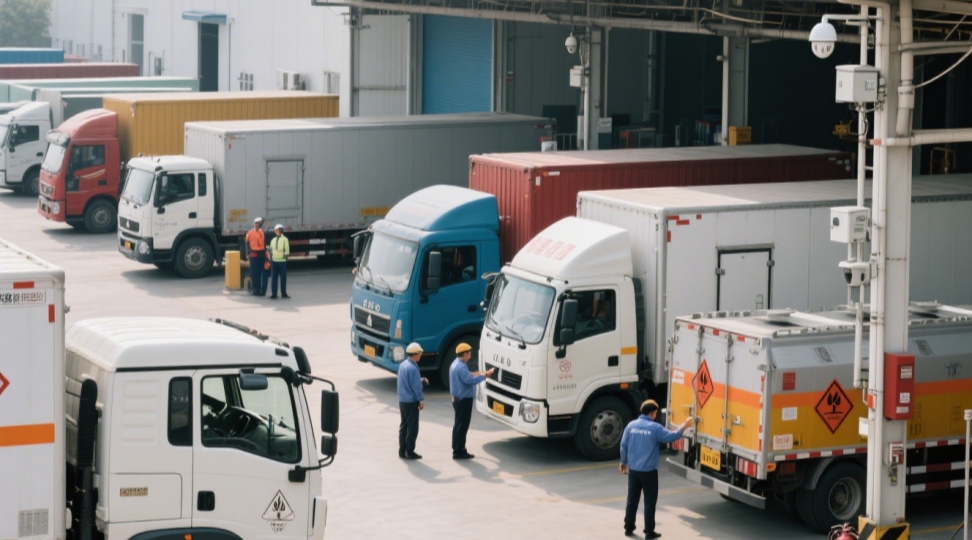Навигация по перевозке опасных грузов: руководство для классов 9
Опасные грузы — это вещества или предметы, представляющие опасность для здоровья, безопасности, имущества или окружающей среды во время транспортировки. Они стандартизированы в системе ООН и классифицируются по 9 классам в зависимости от их основных опасностей. При более чем 11 миллионах поставок в год понимание этих категорий и протоколов соответствия имеет решающее значение для безопасной перевозки опасных грузов.
9 классов опасных грузов: что вам нужно знать
Класс 1: Взрывчатые вещества
Вещества, реагирующие бурно (например, динамит). Требуют противоударной упаковки и изоляции от источников тепла.
Класс 2: Газы
Сжатые газы (например, пропан, аэрозольные баллончики). Баллоны должны быть установлены вертикально и иметь защиту клапанов.
Класс 3: Легковоспламеняющиеся жидкости
Жидкости с температурой вспышки ≤61°C (например, бензин, ацетон). Требуются паронепроницаемые контейнеры.
Класс 4: Легковоспламеняющиеся твердые вещества
Включает в себя самовозгорающиеся (например, фосфор) или реагирующие с водой материалы (например, натрий). Требуются сухие, проветриваемые помещения.
Класс 5: Окислители и органические пероксиды
Окислители (например, перекись водорода), усиливающие возгорание. Изолировать от горючих материалов.
Класс 6: Токсичные и инфекционные вещества
Яды (например, пестициды) и биологически опасные вещества (например, медицинские отходы). Обязательно герметичная, непротекаемая упаковка.
Класс 7: Радиоактивные материалы
Предметы, испускающие ионизирующее излучение (например, уран). Применяются экранированные контейнеры и строгие ограничения по количеству.
Класс 8: Коррозионные вещества
Кислоты/щелочи, вызывающие повреждение тканей или металла (например, серная кислота). Стеклянные и пластиковые контейнеры требуют амортизации ударов.
Класс 9: Разные опасные грузы
Опасные материалы не охвачены выше. Включает литиевые батареи, сухой лед, асбест и опасные для окружающей среды вещества.
Таблица: Краткое справочное руководство по классам опасных грузов
| Сорт | Тип опасности | Распространенные примеры | Правило транспортировки ключей |
|---|
| 1 | Взрыв | Динамит, фейерверки | Воздушный транспорт отсутствует. |
| 2 | Утечка газа | Пропан, аэрозоли | Вертикальное хранение баллонов |
| 3 | Пожар/взрыв | Бензин, ацетон | Паронепроницаемые контейнеры |
| 4 | Самовозгорание | Натрий, фосфор | Сухая среда |
| 9 | Множественные подриски | Литиевые батареи, сухой лед | Уровень заряда ≤30% для воздуха (IATA 66th DGR) |
Виды транспорта и рамки соответствия
Воздушный транспорт
Регулируется Правилами перевозки опасных грузов ИАТА (DGR 66th, вступают в силу с января 2025 г.).
Ключевые обновления: литиевые батареи емкостью более 100 Вт·ч имеют ограничение по уровню заряда в 30%; новые сводки цифровых испытаний.
Запрещает перевозку взрывчатых веществ (класс 1) и радиоактивных материалов (класс 7) на пассажирских рейсах.
Морские перевозки
Соответствует Международному кодексу морской перевозки опасных грузов (IMDG).
Требуется декларация DG, маркировка контейнера и разделение по типу опасности.
Такие порты, как Таллин, полностью запрещают перевозки грузов класса 1.
Автомобильный/железнодорожный транспорт
Использует ADR (Европа) или национальные рамки (например, FMCSA в США).
Основное внимание уделяется устойчивости груза, обучению водителей и аварийным комплектам.

Опасные грузы класса 9: «Разное»
Часто неправильно понимаемые, к классу 9 относятся следующие опасные грузы:
Литий-натриевые батареи (ООН 3480/3090)
Сухой лед (ООН 1845)
Генетически модифицированные организмы (ООН 3245)
Экологически опасные вещества (например, загрязнители морской среды, ООН 3077).
Критически важно для литиевых батарей:
Для воздушного транспорта требуются следующие показатели мощности в ватт-часах (Вт·ч):
Непроливающиеся батареи с жидким электролитом (например, свинцово-кислотные) должны иметь напряжение ≤12 В и емкость ≤100 Вт·ч.
Подготовка документации: ключ к гладкому таможенному оформлению
Перевозка опасных грузов требует точного оформления документов:
Паспорта безопасности (SDS): должны соответствовать IATA DGR 66-го издания (2025 г.) для воздушных перевозок или IMDG для морских перевозок.
Транспортные документы:
Сертификаты на упаковку: контейнеры, одобренные ООН, с протоколами испытаний.
Совет: используйте автоматизированные платформы, такие как DR Trans' Document Hub для создания соответствующих этикеток и форм.
Импорт опасных грузов: контрольный список перед отправкой
Перед международной перевозкой опасных грузов:
Проверка классификации: подтверждение с помощью паспорта безопасности или лабораторных испытаний (например, температура вспышки для жидкостей, LC50 для токсичных веществ).
Проверьте запреты: некоторые порты ограничивают провоз определенных классов (например, взрывчатых веществ в Таллине).
План действий в чрезвычайных ситуациях: оснастите транспортные подразделения комплектами для ликвидации разливов и СИЗ.
Партнеры по аудиту: убедитесь, что перевозчики имеют сертификаты об обучении работе с опасными грузами.
Доставка из Китая: индивидуальные решения DR Trans
Перевозка опасных грузов из Китая включает в себя:
Выбор метода:
Море: Экономически выгодно для крупных опасных грузов класса 9 (например, аккумуляторы). Транзит: 25–40 дней.
Авиаперевозки: срочные перевозки (3–10 дней); в соответствии с IATA DGR 66th.
Критические шаги:
Упаковка: коробки, сертифицированные ООН, с этикетками, предупреждающими об опасности (например, ромб «Разное» для класса 9).
Изоляция: Отделите батареи от горючих материалов.
Декларации: аннотации к транспортной накладной и предварительные таможенные уведомления.

Как DR Trans обеспечивает соблюдение требований:
Комплексная экспертиза по классу 9: от подготовки паспортов безопасности до упаковки в соответствии с IMDG/ADR.
Взаимоотношения с портами: приоритетная швартовка для грузов DG в Шанхае/Нинбо.
Отслеживание в реальном времени: мониторинг температуры/давления для чувствительных предметов.
Заключительные мысли
Знание классов опасных грузов и правил транспортировки предотвращает задержки, штрафы или инциденты. С развитием правил, таких как IATA DGR 66-го издания и обновления Международного кодекса морских опасных грузов, партнерство со специалистами не подлежит обсуждению.
Независимо от того, перевозите ли вы литиевые батареи (класс опасных грузов 9) или едкие вещества, команда DR Trans оптимизирует вашу цепочку поставок. Ознакомьтесь с нашими решениями по опасным грузам— где соответствие требованиям соответствует надежности.
У вас сложные поставки DG? 87% задержанных грузов не имеют надлежащего SDS или маркировки. Проведите аудит вашего процесса сегодня.
















 IPv6 ПОДДЕРЖИВАЕТСЯ СЕТЬЮ
IPv6 ПОДДЕРЖИВАЕТСЯ СЕТЬЮ
